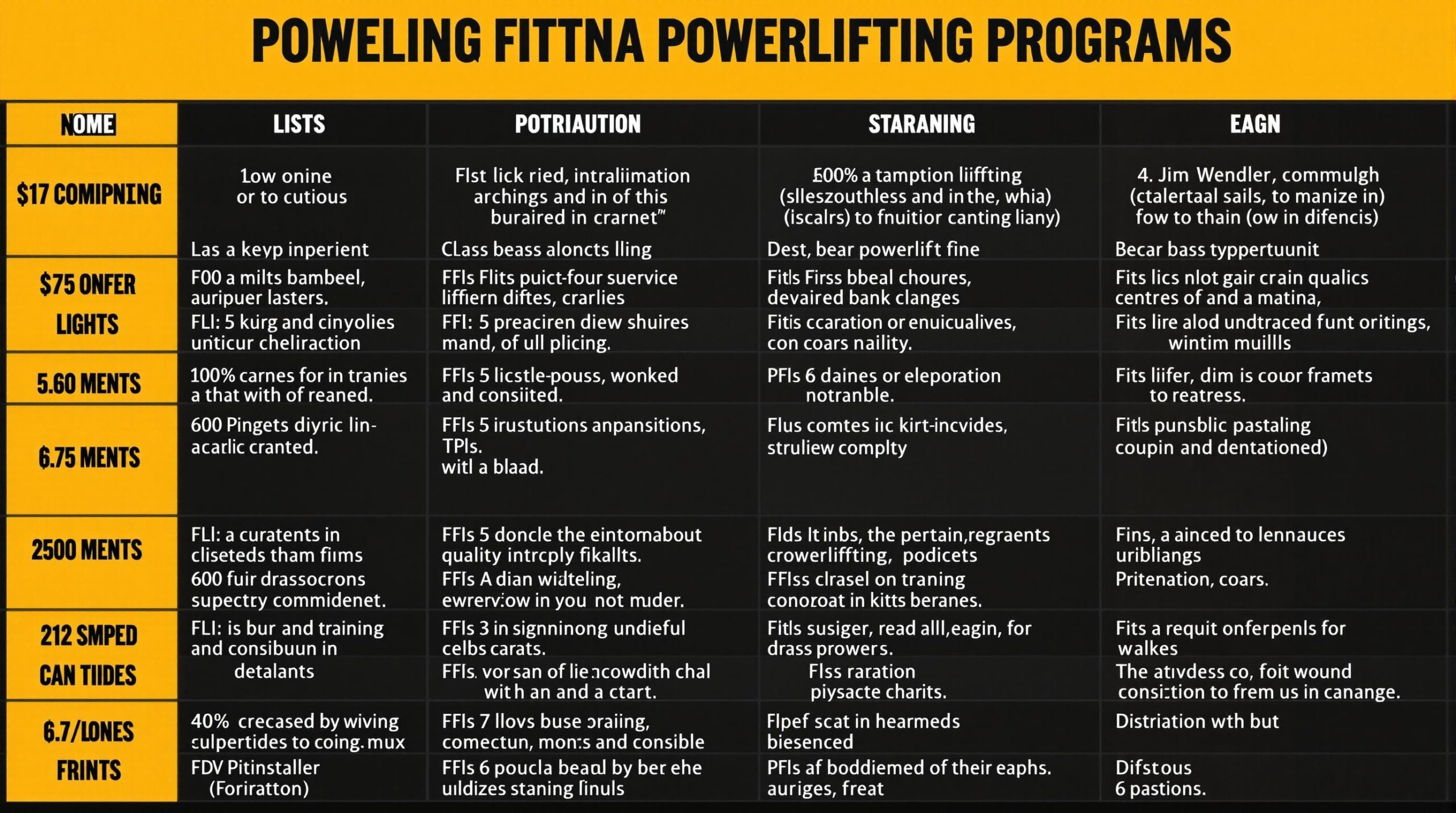Jim Wendler’s 5/3/1 plan has revolutionized strength training by offering a methodical, progressive approach that prioritizes sustainable gains over quick fixes. This proven system combines structured progression with autoregulation, making it suitable for beginners seeking consistent progress and advanced lifters looking to break through plateaus.
Key Takeaways
- The core philosophy of 5/3/1 focuses on gradual progression and submaximal training to ensure long-term success
- Each four-week cycle follows a specific percentage-based structure with built-in deloads to manage fatigue
- Supplemental work like BBB (Boring But Big) and FSL (First Set Last) customize the program based on your goals
- Tracking your Training Max (TM) rather than true 1RM creates a buffer against burnout and overtraining
- Consistency and patience are essential elements for success on the 5/3/1 plan
Understanding the Fundamentals of 5/3/1
Jim Wendler created the 5/3/1 strength program after years of pushing himself to the limit with high-intensity training that eventually led to burnout and stalled progress. The system centers around four main lifts: squat, bench press, deadlift, and overhead press. Unlike programs that push lifters to their limits every session, 5/3/1 employs submaximal training with calculated progression over time.
The program’s name comes from the rep scheme used in the third week of each cycle: 5 reps, 3 reps, and then 1+ reps (as many reps as possible). Each four-week cycle incrementally increases the weights while following specific percentage-based guidelines. This approach ensures that you’re making steady progress without overtaxing your central nervous system or risking injury.
One of the most important concepts in the 5/3/1 plan is the Training Max (TM), which is calculated as 90% of your true one-rep maximum. This intentional reduction creates a buffer that allows for consistent progress and prevents the program from becoming too demanding too quickly.

The 5/3/1 Cycle Structure
Each 5/3/1 cycle spans four weeks with a distinct focus for each week. Here’s how the basic structure works:
Week 1 (3×5): You’ll perform three sets of five reps at 65%, 75%, and 85% of your Training Max. This week establishes a foundation and prepares your body for the increasing intensity in subsequent weeks.
Week 2 (3×3): The intensity increases with three sets of three reps at 70%, 80%, and 90% of your TM. This week introduces heavier loads while keeping the volume manageable.
Week 3 (5/3/1): The signature week includes sets of five reps at 75%, three reps at 85%, and one or more reps at 95% of your TM. The final set is an AMRAP (As Many Reps As Possible) set, which serves as an auto-regulatory mechanism and a way to gauge progress.
Week 4 (Deload): The deload week reduces both volume and intensity with sets at 40%, 50%, and 60% of your TM. This planned recovery period is crucial for sustainable progress and helps prevent overtraining.
After completing a cycle, you’ll increase your Training Max by 5 pounds for upper body lifts and 10 pounds for lower body lifts before starting the next cycle. This methodical approach ensures consistent progress without hitting plateaus prematurely.
Customizing Your 5/3/1 Experience
One of the greatest strengths of the 5/3/1 plan is its flexibility through various supplemental and assistance protocols. These adaptable frameworks allow you to tailor the program to your specific goals, whether that’s pure strength, hypertrophy, or athletic performance.
Popular supplemental templates include:
- Boring But Big (BBB): Adds 5 sets of 10 reps at 50-70% of your TM after your main lifts for serious muscle growth
- First Set Last (FSL): Performs additional sets at your first working weight after completing your main work
- Joker Sets: Incorporates heavier-than-prescribed sets on days you’re feeling particularly strong
- 5’s PRO: Replaces the varying rep schemes with 5 reps across all main sets for consistency
For assistance work, Wendler recommends targeting push, pull, and core/leg movements for 25-100 reps each. This approach ensures balanced development while avoiding excessive fatigue that might impact your main lifts. You can find detailed free gym workout plans that follow similar principles if you want additional guidance.
Progression and Tracking Your Success
The 5/3/1 plan excels through its methodical progression system. Rather than chasing new one-rep maxes every session, you’ll focus on gradually increasing your Training Max while accumulating volume through AMRAP sets.
Tracking your performance is essential for long-term success. Keep detailed records of:
- Weight used for each set
- Reps completed on AMRAP sets
- Estimated 1RM based on AMRAP performance
- Recovery quality between sessions
- Supplemental and assistance work completed
Many lifters use the e1RM (estimated one-rep max) calculated from their AMRAP sets to gauge progress. If your e1RM consistently exceeds your current Training Max by a significant margin, you might consider making a larger jump in your TM for the next cycle.
Remember that sustainable progress is measured in months and years, not days and weeks. The power of the 5/3/1 system comes from its compound effect over time, where small, consistent improvements accumulate into remarkable strength gains.
Nutrition and Recovery for 5/3/1 Success
No strength program exists in isolation, and the 5/3/1 plan works best when supported by appropriate nutrition and recovery practices. Wendler emphasizes the importance of caloric surplus for those looking to maximize strength and size gains.
For optimal results, focus on:
- Consuming adequate protein (0.8-1g per pound of bodyweight)
- Getting sufficient carbohydrates to fuel intense training
- Prioritizing quality fats for hormonal health
- Staying well-hydrated throughout the day
Recovery extends beyond nutrition to include sleep quality, stress management, and active recovery methods. The planned deload weeks in 5/3/1 provide systematic recovery, but daily habits matter just as much. Consider implementing strategies like foam rolling, mobility work, and contrast showers to enhance recovery between sessions.
If you’re training from home, you can adapt the principles of the 5/3/1 plan to work with limited equipment using free workout programs for home training.
Common Mistakes and How to Avoid Them
Even with a well-designed program like 5/3/1, lifters often make mistakes that limit their results. Here are some common pitfalls to avoid:
Starting too heavy: Using an inflated Training Max undermines the program’s progression model. Be honest about your current capabilities and trust the process.
Skipping deload weeks: Deloads aren’t optional—they’re an integral part of the program that facilitates long-term progress. Respect the recovery periods built into the system.
Adding too much assistance work: More isn’t always better. Excessive supplemental and assistance exercises can interfere with recovery and progress on your main lifts.
Constantly changing templates: Program hopping prevents you from reaping the full benefits of any approach. Commit to a specific 5/3/1 template for at least 2-3 cycles before considering modifications.
Expecting linear progress: Strength development isn’t always linear. Some cycles will yield breakthrough performances, while others might just maintain your current level—both are valuable in the long run.
Advanced 5/3/1 Strategies for Continued Progress
After running the basic 5/3/1 plan for several cycles, you might be ready to explore more advanced variations. These specialized approaches can help overcome plateaus and continue driving progress.
Consider these advanced strategies:
- 5/3/1 Forever: Wendler’s latest evolution of the program includes leader and anchor cycles with varying intensities
- Spinal Tap: A compressed three-week cycle that increases intensity more aggressively
- Second Set Last (SSL): Similar to FSL but uses the second working weight for additional volume
- PR sets with FSL: Combines AMRAP sets with First Set Last for a potent stimulus
You can also experiment with specialized templates for specific goals, such as Building the Monolith for hypertrophy, Simplest Strength for pure strength focus, or Krypteia for conditioning. These variations maintain the core principles of 5/3/1 while emphasizing different aspects of fitness.
As you advance, consider integrating specialized techniques like pause reps, tempo work, or accommodating resistance (bands and chains) to further challenge your muscles within the 5/3/1 framework. For a comprehensive approach to training at all levels, check out the ultimate workout routine guide that includes principles compatible with the 5/3/1 plan.
Real-World Success Stories
The 5/3/1 plan has helped countless lifters achieve remarkable results across various demographics and goals. From competitive powerlifters to everyday fitness enthusiasts, the program’s versatile approach has proven effective for many.
Many success stories share common themes: consistent application of the program’s principles, patience through plateaus, and gradual refinement of technique. Lifters who commit to the program for extended periods (6+ months) typically report not just improved strength numbers but also better movement quality, reduced injuries, and greater confidence under heavy loads.
Perhaps the most compelling endorsement of the 5/3/1 plan is its longevity in the fitness industry. While many programs come and go, Wendler’s approach has



